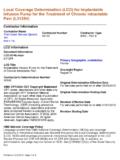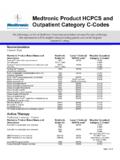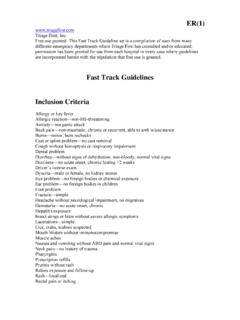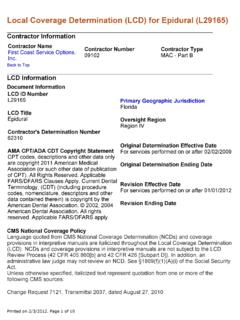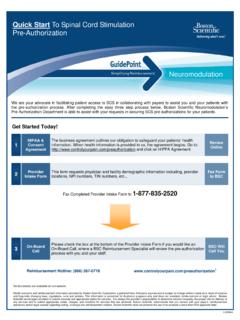Transcription of MODEL POLICY ON THE USE OF OPIOID ANALGESICS IN THE ...
1 Federation of State Medical Boards | 3 MODEL POLICY ON THE USE OFOPIOID ANALGESICS IN THE treatment OF chronic PAININTRODUCTIONThe Federation of State Medical Boards (FSMB) is committed to assisting state Medical Boards in protecting the public and improving the quality and integrity of health care in the United States. In 1997, the FSMB undertook an initiative to develop MODEL guidelines and to encourage state medical boards and other health care regulatory agencies to adopt policies encouraging safe and effective treatment of patients with pain , including, if indicated, the use of OPIOID ANALGESICS .
2 [1]. The FSMB updated its guidelines in 2003 [2] so that its MODEL POLICY would reflect the best available evidence on management of pain and give adequate attention to both the undertreatment and overtreatment of pain and the inappropriate use of OPIOID these initiatives, the FSMB has sought to provide a resource for use by state medical boards in educat-ing their licensees about cautious and responsible prescribing of controlled substances while alleviating fears of regulatory scrutiny. The FSMB recognizes that inappropriate prescribing can contribute to adverse outcomes such as reduced function, OPIOID addiction, overdose, and death [3-5].
3 By promulgating its MODEL Policies, the FSMB has sought to provide a framework for the legitimate medical use of OPIOID ANALGESICS for the treatment of pain while emphasizing the need to safeguard against their misuse and their publication, the 1998 and 2004 MODEL Policies have been widely distributed to state medical boards, medical professional organizations, other health care regulatory boards, patient advocacy groups, pharmaceuti-cal companies, state and federal regulatory agencies, and practicing physicians and other health care providers.
4 The policies have been endorsed by the American Academy of pain Medicine, the Drug Enforcement Admin-istration, the American pain Society, and the National Association of State Controlled Substances Authorities. Many states have adopted all or part of the MODEL updated MODEL POLICY presented here reflects the considerable body of research and experience accrued since the 2004 revision was adopted [2]. While recognizing that adequate evidence is currently lacking as to the effectiveness and safety of long-term OPIOID therapy, this MODEL POLICY is designed to promote the public health by encouraging state medical boards to adopt consistent POLICY regarding the treatment of pain , particularly chronic pain , and to promote patient access to appropriate pain management and, if indicated, substance abuse and addiction treatment .
5 The MODEL POLICY emphasizes the professional and ethical responsibility of physicians to appropriately assess and manage patients pain , assess the relative level of risk for misuse and addiction, monitor for aberrant behaviors and intervene as appropriate. It also includes references and the definitions of key terms used in pain As of March 7, 2012, 57 of 70 State Medical Boards have POLICY , rules, regulations or statutes reflecting the Federation s 1997 or 2004 MODEL Guidelines for the Use of Controlled Substances for the treatment of pain .
6 1 MODEL POLICY for the Use of OPIOID ANALGESICS in the treatment of chronic Pain4 Federation of State Medical Boards | FSMB encourages every state medical board to work with the state attorney general to evaluate the state s policies, regulations and laws in an effort to identify any barriers to the effective and appropriate use of opioids to relieve pain , while ensuring that adequate safeguards are in place to deter and rapidly detect those who would obtain OPIOID ANALGESICS for nonmedical purposes [6-7].The FSMB acknowledges with gratitude the efforts of the state board members and directors who collaborated to prepare this updated MODEL POLICY , as well as the contributions of the independent experts and medical organizations that advised the drafting committee and reviewed its work.
7 The FSMB also thanks SAMHSA for its support of this important ADDRESSED IN THE NEW MODEL POLICYT here is a significant body of evidence suggesting that many Americans suffer from chronic pain and much of that pain is inadequately or ineffectively treated[8-10]. Since the 2004 revision, evidence for risk associated with opioids has surged, while evidence for benefits has remained controversial and insufficient. Over the last decade, there has been a parallel increase in OPIOID sales and an increase in morbidity and mortality associated with these drugs.
8 At the same time, approximately one in four patients seen in primary care settings suffers from pain so intense as to interfere with the activities of daily living [4]. pain arises from multiple causes and often is categorized as either acute pain (such as that from traumatic injury and surgery) or chronic pain (such as the pain associated with terminal conditions such as cancer or severe vascular disease or with non-terminal conditions such as arthritis or neuropathy) [4,8]. This MODEL POLICY applies most directly to the treatment of chronic pain and the use of OPIOID ANALGESICS but many of the strategies to improve appropriate prescribing and mitigate risks can be applied to the use of other controlled medications and to the treatment of acute of pain is recognized as a serious public health problem that compromises patients functional status and quality of life [4,9].
9 A myriad of psychological, social, economic, political, legal and educational factors including inconsistencies and restrictions in state pain policies can either facilitate or impede the ability and willingness of physicians to manage patients with pain [6,10-11].While acknowledging that undertreatment of pain exists, it must be understood that chronic pain often is intractable, that the current state of medical knowledge and medical therapies, including OPIOID ANALGESICS , does not provide for complete elimination of chronic pain in most cases, and that the existence of persistent and disabling pain does not in and of itself constitute evidence of undertreatment [4,8,12].
10 Indeed, some cases of intractable pain actually result from overtreatment in terms of procedures and the picture, adverse outcomes associated with the misuse, abuse and diversion of prescription opioids have increased dramatically since the FSMB s last review [3]. Physicians and other health care profes-sionals have contributed often inadvertently to these that contribute to both the inadequate treatment of pain and the inappropriate prescribing of opioids by physicians may include: (1) physician uncertainty or lack of knowledge as to prevailing best clinical practices; (2) inadequate research into the sources of and treatments for pain ; (3) sometimes conflicting clinical guidelines for appropriate treatment of pain .
